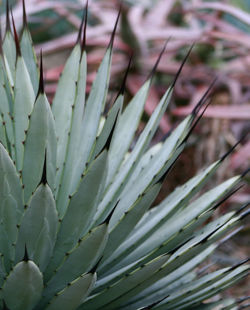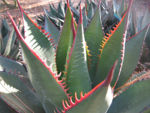Agave
| Agave |
|---|

|
| Scientific Classification |
|
| Species |
Over 300 described.
|
The origin of the Agave plant is that Spanish as well as Portuguese explorers brought this particular plant back to Europe on there return to their homeland from the United states where it was originally found. The Agave became common in the European region in the 19th century. During this time period, the Agave plant was collected by those who used them for style and as a collectors item. The agave plant has a lengthy history and it is now known Agave was preserved were used for trade or barter between tribes because it was known as a very valuable plant. The Agave also produces products which are used for Ethnomedical Uses. A few of the common uses are used to relieve constipation and excess gas. The liquid of the Agave plant is also used to increase the rate of "bodily urine excretion".[1]
Anatomy
Agave plants commonly have rather thick fleshy leaves that have an end that is sharp, and comes to a point. They often also have a spiny margin, which is one example of why they are commonly known as a cactus. The stem of the plant is usually short in length. The leaves of the Agave sprout from the roots as seen in the pictures above. Each of the Rosettes of the plant are monocarpic which means that they are plants can be kept alive after flowering if the flowers are removed as soon as they are done blooming, before seed formation begins. [2]
Specific Species
- Agave americana-- possesses extremely admirable evergreen foliage, which usually has a blue-green blue green color that closely resembles a Lilac. After the plant is mature(usually after approximately 10 years), it acquires dry area qualities, as well as creating a bloom stalk. Originally is adapted to a moist climate and soil environment.
- Agave deserti-- The deserti species of the Agave has firm but juicy leaves. These leaves closely resemble a sword shape, and commonly have a blue-green color. The leaves of the deserti agave are extremely sharp, due to their sharp spines on the end of their leaves. The outside of the leaf possesses marginal teeth. The leaves that are produced are approximately 2 feet high and around 6 feet wide. Although this is the normal height, the size varies depending on the environment and growing conditions. When the plant becomes mature it develops stalks that flower that can grow to be 6-9 feet tall. On these stalks, there are clusters that create a mound shape that is flowered and is usually a yellow color.
- Agave havardiana-- The leaf complexity of the Havardiana is simple. The leaf margin of this particular species is dentate. The apex of the leaves are acute. The most commonly found colors of this particular species are yellow and green. This species has leaves which are fleshy, as well as having margins which are toothed. The common growth period of this Agave is approximately 20- 40 years. When it has reached this mature age, they develop branched flower stalks which perish in the summer seasons.
- Agave lechuguilla-- the leaf complexity of the lechuguilla is simple. The average height of this species ranges from 12-36 feet. The most commonly found colors of this species include white, pink, and yellow. The leaves normally have a leathery texture, as well as having a tip that has a strong spine on the end.
Interesting Fact-- During the days in which exploration of the states was prominent, the lechuguila species created a deadly obstacle for those who were exploring the southwest by ways of horses, because when riding, the leaves which were very sharp would puncture the horses' legs. Not only was the horse fatally wounded, the rider which was thrown from the horse would be impaled by the dealdy spines of the Agave plant impaled.
- Agave univittata-- The leaf complexity of the univittata is simple. The root type is fibrous. It has a linear shape. The venation of this species is parallel, as well as the leaf pubescence being glabrous. The leaf apex is accuminate, and the leaf base is truncate. The pistils of the plant are elongate, filiform, tubular. The average height of the plant is 1-3 feet. When the blooms are produced they are usually a green color.
- Agave palmeri-- The leaf complexity of the Palmeri is simple. The duration of the plant is Perennial. The height is approximately 1-3 feet. The commonly found colors are yellow and green. The leaves of this particular species are firm, juicy, resembles a sword, and have spines on the end of each leaf. This species commonly have a tall flower stalk which is naturally branched. It grows from center of the rosette, which is thick as well as rigid.
- Agave parryi-- The leaf complexity of the Parryi is simple. It bears a rosette (like all other Agave plants) which is stiff, juicy, and resembles the shape of a sword. The leaves support a group of yellow flowers which are located at the tip of the leaves.
- Agave shawii-- The leaf complexity of the Shawii is simple. The duration of this species is perennial. The normal bloom colors of this species are yellow and green. This species has a trunk which is traditionally spiny to the touch. The trunks of the plant creep along the ground as well as spreading from the base of the plant. The leaves of the plant have prickles that are red in color, as well as having a terminal spine. A flowering stem appears on the plant after about 8-20 years of maturation.[3]
Reproduction
The agave plant produces a flat disk seed that in enveloped by the capsule which aid in reproduction of the species. The seeds multiply by various ways of division which includes offshoot of "pups". Because the Agave plant is commonly grown for a large variety of uses, growers mass produce these plants using their seeds which are produced to reproduce these plants in areas where the species may grow properly.[4]
Ecology
In order for the the Agave plant to thrive in its environment it must have full exposure to the son. Another vital demand of the Agave genus is reflected heat which helps in the growth of the plant. Moisture is essential to the growth and active life of the Agave. A few of the common sources of this moisture are: supplement water, rainfalls which are natural, as well as streams and rivers. A requirement for the Agave is soil. The most ideal soil conditions are that which are tolerant of weather conditions, and soil that is well drained.[5] The most common habitat of the Agave is mainly in Mexico few other areas that they inhabit are southern and western United States. They also are found in central South America, where tropical weather may be found. The growing conditions varies greatly throughout the different species which are listed above. Such habitats varies anywhere from a desert environment to that which needs extreme moisture for maximum growth.
Common Uses
The Agave plant provides a plethora of uses. The flowers, the leaves, the stalks (basal rosettes), and the sap are all able to be eaten by human beings. Every year, the agave plant creates pounds of plants which are edible to those who are in need of nourishment while in the desert or wilderness. The plant becomes full of sap during the winter and spring. At this time, growers collect the leaves, because they are able to be sold for a profit. The stalk of this plant can be eaten. The most common way of cooking this part of the plant is by roasting. When roasted the stalk becomes sweet. There is a rush of sap to the base of flower stalk during the development of inflorescence.[6] (a group or cluster of flowers on a branch of a plant. In botany the term refers to the way individual flowers are arranged on the plant.)[7] This sap is used to make Mexico's national drink, Pulque. The sap that is collected after this process is fermented, and is ultimately used to make tequila. The Mexican government and European officials made strict regulations regarding the use of this plant to make 100% tequila using only the Weber Blue Agave plant to make Blue Agave Tequila. The part of the plant, known as the stem, when cut and sliced, makes a "razor strop". The juices that are excreted from the plant often lathers in water. A few other used of the needles of the Agave are to make pens, nails and needles, and strings to sew and make weavings. Individuals use the nectar from the Agave as a substitute for syrup, because it is more cost effective.[8] Native Americans used the Agave Palmeri to produce nourishment and use them in their food, beverages, fiber, soap, medicine, and lances.[9]
Gallery
See Also
Related References
- Wikipedia Free online Encyclopedia. Many authors
- Pima County Home HorticultureCompiled by the Master Gardenersof the University of Arizona Pima County Cooperative Extension
- capital museum compiled works of museum authors describing the Agave species
- Native Plant Information NetworkLady Bird Johnson Wildflower Center; Located at the University of Texas in Austin (a.k.a. Native Plant Information Network)








